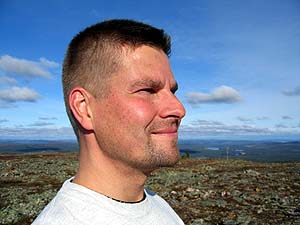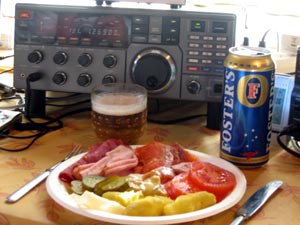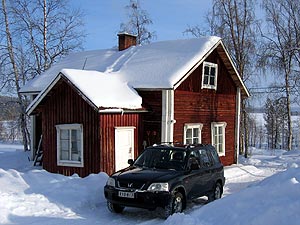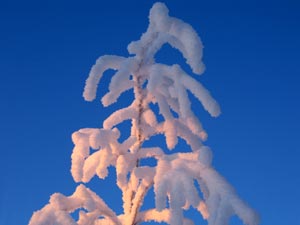|
Minimum Highlights
by Jim
Solatie
When you have been DX listening
for almost 30 years, and have a collection of radio
verifications from over 4500 different broadcast
stations, it is not so easy to find new highlights
on the AM band. This is the reason why I had been
expecting solar minimum so much. Mediumwave conditions
are excellent, and you can find previously unheard
stations. Luckily this solar minimum was not an
exception. Here are my personal highlights from
the season 2007-2008. I have also added audio files
of most of the stations mentioned in this short
article. Please enjoy, some of the audio clips are
astonishing.
During the solar minimum
1986-87 I served in the military. The next minimum
in 1996-97 was overloaded with work at my small
new company and it was impossible to enjoy dxing
as much as I would have wanted. So I promised myself
that during this minimum I will concentrate all
my efforts into listening. Well, naturally as an
entrepreneur you can never leave the work totally,
but we had recently hired an excellent managing
director, and it was possible to leave the daily
burden to him.
Actually I had decided to write
a business book, which gave me the possibility to
escape the daily hazzle, jump into the train and
travel to Lemmenjoki, the radio listeners' paradise
in Northern Finland. In Lemmenjoki I enjoyed the
beautiful nature, relaxing atmosphere, writing the
book and listening to distant radio stations.
September
In September I spent one week
alone in Lemmenjoki. The exact dates were September
15-23, which means that listening was concentrated
only to sunrise and sunset. At daytime it is too
sunny, thus no mediumwave signals are heard. Nighttime
on the other hand is usually quite boring, unless
Brazilians start coming in around midnight. This
time they didn't.

The writer smiling on top of Joenkielinen (534
meters). |
However, this week's sunsets
were quite good, resulting in many new Asian stations.
And sunrises - they were spectacular! The best of
all was Saturday morning, the 22nd of September.
On European dominated frequencies like 1440 and
1530 many interesting Central and South American
stations were heard. Radio Impactante from the Dominican
Republic dominated the frequency 1440 kHz, leaving
no chance to European superpowers in Russia and
Luxembourg. On 1530 kHz it was not Romania, as usual,
but Ondas Cañaris from Azogues, Ecuador,
and Radio
Milenia from Lima, Peru (you can enjoy the clip
by clicking the link). Especially Milenia's signal
was fantastic: "Radio Milenia 1530" It
is amazing that previously unheard stations (in
Europe) can have signals like this.
October
A week later, between 28th September
and 6th October it was time to return to the DX
paradise. Writing was proceeding well and mediumwave
conditions were staying at an excellent level. Days
were getting a bit shorter, so Asian stations were
coming in earlier, and Trans-Atlantic stations stayed
audible till mid morning. Now I was in Lemmenjoki
with my good DX friend Håkan Sundman. It was
the 9th DX-expedition we made together.

Listening to 2SM Sydney
on 1269 AM |
Chinese stations, how I love
them. Superpowers can of course be heard almost
daily, but local stations are much harder. This
time we had the chance to hear many unheard wonders,
like Wuhai
PBS (Wuhai People's Broadcasting Station) from
Wuhai, Nei Menggu on 747 kHz, identifying even in
English: "This is Wuhai Radio on 87.8 FM and
747 AM" and Jinzhou
PBS from Jinzhou, Liaoning Province on 774 kHz
identifying "Zhongbo 774 qianhe, Jinzhou Renmin
Guangbo Diantai, zhongbo jinji guangbo, zhu nin
wan an."
We had been listening for 5 days,
and were extremely happy with the results. But we
couldn't even imagine what was going to happen.
Something totally unbelievable.
It all started at 1510 UTC on
Thursday, the 4th October. Suddenly the mediumwave
band was full of Aussies. The first one we noticed
was on 1062 kHz, which is the frequency for ABC
Far North Queensland in Thursday Island, Qld.
The programming was ABC's 'Nightlife' with Tony
Delroy, but nevertheless it was a once-in-a-lifetime
experience. A few months later I learned that ABC
Far North had made a short story about my reception
report in their nationwide night programme. Please
enjoy it here: ABC's
Christmas Night programme.
Conditions were over in 30 minutes,
but still we were able to identify eleven non X-band
Aussies (meaning 531-1602 kHz). Nine of these were
previously unheard in Finland. ABC
Townsville in Queensland on 630 kHz had clearly
the best reception quality. In fact it was perhaps
the most powerful station on the whole band, including
Europeans. Some other highlights were 2SM
Talkback from Sydney, NSW on 1269 kHz and 2BS
Gold from Bathurst, NSW on 1503 kHz

Lemmenjoki headquarters
in winter coat, January 2008 |
There is one more station I must
mention: Cross
Radio from Pohnpei, Micronesia on 4755 kHz shortwave.
Rarely these days can you find new ones on shortwave,
but every now and then there are real gems available.
The Cross was definitely one of those most valuable
treasures. Micronesia was also a new DX country
for me and what made it so special was that one
year earlier I had visited Micronesia. When island
hopping between the four Micronesian states Chuuk,
Pohnpei, Kosrae and Yap, I was dreaming that one
day I will hear this country in Finland. That dream
came now true - only 14 months later.
November
Early November, the 3rd to the
11th, was extremely quiet in the sun. Days were
getting very short, so it was possible to enjoy
North American mediumwave stations from midnight
till late afternoon, almost 18 hours a day. But
despite the great DX conditions, when you have nearly
1000 verified North Americans, it is not easy to
identify new ones.
This week I was in Lemmenjoki
with Lauri Niemi, to whom most of the stations were
new. He was able to make over 220 reception reports
that week. I had to satisfy myself with some 30
new stations. But I was satisfied, especially when
some new stations had a fantastic reception quality.
Take a listen to WLNO
New Orleans, LA on 1060 at 2300 UTC, just before
they reduce their daytime power from 50 000 watts
to 5,000 watts. KJUG
Tulare, CA on 1270 kHz was another highlight,
as well as '1560 The Game', KGOW
Bellaire, TX. Please enjoy these rare signals.
December-January
Early December went on business
trips to Moscow and Guangzhou, and the Christmas
Eve was spent naturally at home, but after that
it was time to return to Lemmenjoki again.
The way this expedition started
was out of this world. The morning hours on the
28th December we (Jari Ruohomäki and myself)
experienced perhaps the best Brazilian conditions
ever. We had many SDR-14 receivers, so we were able
to cover almost the whole mediumwave band. Signals
were astonishing between 0650 and 0750 UTC, meaning
that most Brazilian stations were on the air already.
Those stations which are silent at nights usually
start the morning at 05 hours local time (07 UTC
when Brazil has summertime). During these perfect
conditions almost all stations had signed on.

The sun shines already
in February |
It took over 80 hours to listen
to all the recordings from this one hour! Samuel
Cassio, the famous Brazilian DXer helped me in solving
some mysteries. His work was so intensive, that
still today I feel sorry about the workload I gave
to him. But Samuel's help was simply fantastic!
During that super hour I was
able to hear 23 personal new Brazilians!!! At least
8 of them were previously unheard in Europe. What
comes to reception quality, Radio
Vale do Jaguaribe, Limoeiro do Norte, CE on
1260 kHz had a nice signal (almost always this frequency
is blocked by Radio Morada do Sol from São
Paulo). Well, you can't blame Radio
Clube's reception quality either. Radio Clube
on 1330 kHz is from Blumenau, SC. A great surprise
was also the frequency 1530 kHz, from which it is
extremely difficult to hear any Latin American stations.
This morning we were able to log three Brazilians:
Radio Tapejara, Tapejara, RS, Radio Porto Feliz,
Mondaí, SC and Radio Sulina, Dom Pedrito,
RS. On 1580 kHz the greatest pleasures were Radio
Pomerode, Pomerode, SC and Radio
Encanto, Encantado, SC.
Among these wonderful Brazilians
I was able to hear Emisora
del Este from Minas, Uruguay. Their reply was
truly personal. Please listen the enclosed clip.
This verification was possible thanks to the help
of Henrik Klemetz, world's best Latin America DX
expert. Henrik has been helping me so much during
the past years, and Emisora del Este was no exception.
After this wonderful Brazilian
hour conditions started to shift to Cuba and USA.
The total amount of new reception reports that day,
the 28th December was an amazing 38! Some of these
new ones came with absolutely perfect reception
quality. Please have a listen to KINF
Santa Maria, CA on 1440 kHz (never heard before
in Europe) and KWEI
Weiser, ID, 'La Caliente' on 1260 kHz (only
heard a handful of times in Finland before). It
was difficult for these stations to believe that
they were received this well in Europe!
Clearly the first day was the
best, but conditions continued very good the whole
week, so when we started to pack things and returned
home on the 5th January, we both had over 7200 hours
of unlistened recordings (I myself had three SDR-14
receivers, Jari four). Of course you can never listen
to all these - or you can, but it would take 180
weeks (over 3 years), if you listen 40 hours a week.
However, every now and then when you have extra
time, it is nice to come back to these perfect conditions.
Actually now in July when I am writing this article
I am listening to 1410 kHz from the 28th December,
and I just found a fascinating new station from
North Dakota, KDKT
Beulah, ND, broadcasting with just 189 watts
at night time. Well, it is still far more than my
personal low power record, WQBR257 Highway Advisory
Radio from Libertyville, IL which I heard a few
years ago on 1620 kHz. Their power is just 5 watts.
But still, any personal new station makes you feel
… well, so, so good!
February
At the end of February it was
time to make our 10th joint DX-expedition with Håkan
Sundman. Once again, it was a splendid week.
On Wednesday, the 27th February
we hit Australia again! During this solar minimum
I spent 37 days in Lemmenjoki, and only twice was
I able to hear Australian mediumwave stations well.
But those two days gave me more than I ever expected.
Some of the highligts on the
27th February were ABC
Perth, Perth, WA on 720 kHz (local station identification
'720 ABC Perth') and ABC
Kimberley, Kununurra, WA on 819 kHz (regional
station identification 'ABC Local Radio WA'). I
also heard an interesting Aussie on 963 kHz with
the programme 'Talking Back The Night'. This programme
is produced by Macquarie Southern Cross Media Network
and they own two stations on 963 kHz which broadcast
it at night time: 5SE Mt. Gambier, SA and 6TZ Bunbury,
WA. Since we heard also many SA (Southern Australia)
stations, as well as many WA stations (Western Australia),
it was impossible to know which of these two stations
was in question. Nevertheless, a wonderful experience.
Among Australians the band was
filled with Chinese stations. For example Zhujiang
EBS from Guangzhou had a splendid reception
quality on 1062 kHz. Please enjoy their advertisement
block on the clip. Also two Indonesian stations
were heard: RRI
Semarang on 801 kHz and RRI
Singaraja on 1080 kHz. In the past 27 DX years
I have heard only two Indonesian mediumwave stations
(RRI Jakarta on 999 kHz and Radio Suara Jakarta
on 1485 kHz). Now it was time to double that amount.
To Maine, North America we experienced
a wonderful 10 minute graveyard opening on the 24th
February. WEZR
Lewiston, ME and WSYY
Millinocket, ME, both on 1240 kHz provided us
fantastic reception quality. The dx-test from WBIX
Natick, MA on 1060 kHz was a truly memorable
experience, too.
Everything good has to end, and
so it was with DX-expeditions during this solar
minimum, too. The very last station we heard was
surprisingly Emissão
Provincial do Niassa from Lichinga, Mozambique
on 1260 kHz. Their high energy Friday night music
programme was a perfect end to this wonderful DX
season.
Apppendix
The book I had been writing on
these DX-expeditions, and between them, is called
"How to raise extremely creative children".
It is aimed at the Chinese market and will be published
in Hangzhou, Zhejiang Province in September 2008.
With the publisher, I am going to join a two-week
marketing tour soon. After that, it is time to start
the next mediumwave season, jump into the train
and travel to Lemmenjoki for another exciting DX-expedition.
It might become interesting, since the experts say
mediumwave conditions are at their best one year
after the solar minimum…
(published on August
18, 2008)
  
|